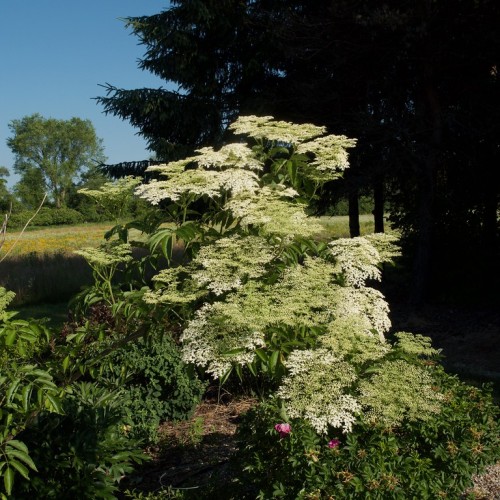
American elderberry
Sambucus canadensis 'Laciniata'
Cycle:
Perennial
Watering:
Frequent
Hardiness Zone:
3 - 9
Flowers:
Flowers
Sun:
Full sun,part shade
Fruits:
Fruits Ready In Fall
Edible:
Yes
Leaf:
Yes
Growth Rate:
Low
Maintenance:
High
Drought Tolerant:
Yes
Care Level:
Medium
watering
American elderberry plants should be watered once a week, providing 1 to 2 gallons of water for each plant. Water the plants until the water starts to run off the base of the plant and the soil is moist. In hotter climates, water more frequently if the soil becomes dry. During periods of drought, occasional deep soaking is necessary to reach the deeper roots and provide the plant with enough water to survive.
sunlight
American elderberry (Sambucus canadensis 'Laciniata') does best in full sun or partial shade. The ideal amount of sunlight for this species is 6 to 8 hours per day. This plant grows especially well in sunny locations with well-draining soils. It can also tolerate some light shade, especially in hot regions. To thrive, it does best when it receives at least 3 hours of direct sunlight each day. Additionally, it will benefit from morning sun or late afternoon sun. American elderberry should not be planted in overly shady spots, as it needs direct light for much of the day.
pruning
American elderberry is a hardy and easy to care for plant that requires minimal maintenance to keep it healthy. Pruning should be done annually after the plant is established, once it has been in place for a couple of years. Pruning should take place in early spring while the plant is still dormant. To begin pruning, you want to remove any dead, diseased, or weak branches by cutting them off at the base. This will help keep the plant healthy by removing any infection that could spread to the rest of the shrub. You will also want to trim back any shoots that have grown 6 to 12 inches beyond the desired shape. You should also remove any suckers that are growing near the base of the plant. This will help keep the elderberry suffocating out any other plants in the vicinity. Finally, thin out any crossed or heavily overlapping branches. This will help keep airflow moving through the shrub to reduce the risk of fungal diseases. After completing your pruning, be sure to apply a layer of mulch around the base of the plant to help retain soil moisture. This will enable the elderberry to thrive in its optimal environment.
